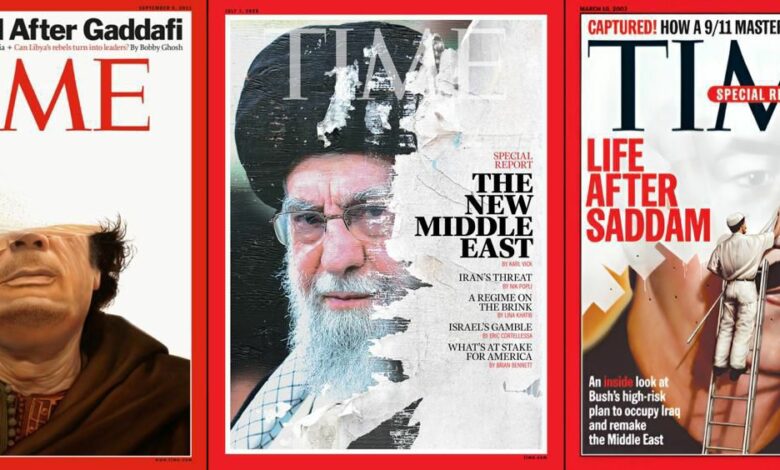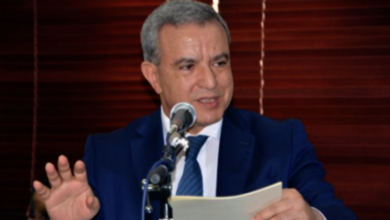From Saddam to Khamenei: TIME Magazine Covers Chronicle the Fall of Iron-Fisted Leaders
From Saddam to Khamenei: TIME Magazine Covers Chronicle the Fall of Iron-Fisted Leaders

ALDAR/ Analysis
In a scene reminiscent of the seismic political shifts that marked the early 21st century, TIME magazine has sparked widespread debate by publishing a recent cover featuring Iran’s Supreme Leader Ali Khamenei, dated June 18, 2025, under a headline suggestive of his political or symbolic downfall. The cover did not go unnoticed, especially as it joins a series of iconic covers that the magazine has dedicated to documenting the fall of globally influential leaders, most notably Saddam Hussein on March 19, 2003, and Muammar Gaddafi on September 5, 2011.
The cover featuring Saddam Hussein followed the U.S.-led invasion of Iraq and bore the headline “Endgame,” at a time when Baghdad was reeling under aerial bombardments and signs of the Ba’ath regime’s collapse were unmistakable. Similarly, the September 2011 cover captured the fall of Libyan leader Muammar Gaddafi after months of bloody conflict and a popular uprising that toppled one of the Arab world’s most enigmatic and authoritarian regimes.
Now, in a visually parallel style, Ali Khamenei appears on the latest TIME cover at a moment loaded with symbolism. It coincides with an unprecedented surge in domestic crises in Iran, intensifying strife between hardliners and popular movements opposing the dominance of the Revolutionary Guard, and a deepening regional and international isolation fueled by sanctions and Tehran’s aggressive regional ventures.
 Although Khamenei remains the Supreme Leader, the TIME cover does not necessarily suggest a physical fall or political assassination. Rather, it may symbolize the end of an era that lasted more than three decades—an era defined by theocratic rule and the establishment of Velayat-e Faqih (Guardianship of the Islamic Jurist) as Iran’s highest political and religious authority.
Although Khamenei remains the Supreme Leader, the TIME cover does not necessarily suggest a physical fall or political assassination. Rather, it may symbolize the end of an era that lasted more than three decades—an era defined by theocratic rule and the establishment of Velayat-e Faqih (Guardianship of the Islamic Jurist) as Iran’s highest political and religious authority.
The American magazine has yet to issue a detailed clarification regarding the content of the new issue, but observers are linking the cover to recent international reports on Khamenei’s deteriorating health, behind-the-scenes power struggles over his succession, and the cumulative pressure from ongoing public protests—from the “Hijab Uprising” to civil disobedience movements in universities, factories, and vital sectors.
TIME has a longstanding tradition of using its covers as symbolic markers of the fall or decline of controversial leaders. These images are often viewed as reflections of deep geopolitical transformations. In Khamenei’s case, the timing of the cover follows what intelligence sources claim was an Israeli airstrike in central Tehran, in which several Iranian military commanders, along with Algerian officers, were reportedly killed—underscoring Iran’s entanglement in sensitive regional arms and funding networks.
Simultaneously, Iran is witnessing increasing social and economic turmoil, fueled by a sharp decline in the value of the rial, heightened repression of activists, and a growing disconnect between the regime and a younger generation yearning for change and openness. Khamenei’s image on the TIME cover appears to symbolize the end of a political chapter more than a specific event.
From Saddam Hussein to Gaddafi, and now Khamenei, TIME has chronicled transformative moments in the Islamic world and the Middle East in particular. Each time, the fall is not just about the demise of a ruler, but the collapse of an ideological and political system once deemed unshakable. The June 2025 cover is nothing less than a mirror reflecting a looming political earthquake—one that could redraw the map of regional and international influence in the Middle East and mark the beginning of a post–Velayat-e Faqih era.





